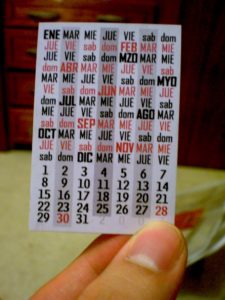2.3: Gramática- La fecha / ¿Cuándo?
- Page ID
- 171371
¿Cuál es la fecha? What is the date?*

In this section, you’ll learn how to tell the date in Spanish. It’s a good thing to know, since otherwise you’re likely to miss flights, appointments, and, yes, dates.**
* “¿Cuál?” means “which”, not “what,” so we might want to think of ¿Cuál es la fecha? as meaning: “Of the many dates out there, which one is this?”
** If you ask someone out on a fecha, however, they won’t know what you’re talking about. For that, try una cita…and ¡Buena Suerte!

Two students in Spanish 1A are practicing a basic conversation of introduction. Read the conversation with another partner and then answer the questions below.
| Sam: | Hola, me llamo Sam. ¿Cómo te llamas? |
| David: | ¡Hola Sam! Me llamo David. ¿Cómo estás hoy? |
| Sam: | Muy bien, ¿y tú? |
| David: | Bien también. Pero (but), ¿qué día es hoy? |
| Sam: | Hoy es lunes, ¿no? |
| David: | Sí, es lunes. No hay un examen en historia hoy. |
| Sam: | ¿Cuándo es el examen? |
| David: | El examen es el catorce de febrero. |
| Sam: | Pero… hoy es el catorce de febrero, lunes. |
| David: | Uh-oh, necesito estudiar. ¡Adiós, Sam! |
| Sam: | ¡Chao, David! |
Objetivos
- Tell the date
- Ask and answer questions with the word ¿cuándo?
La fecha
The verb ser is used to give dates:
Carmen: ¿Cuál es la fecha de hoy? (What is today’s date?)
Ramón: Hoy es el 20 de mayo. (Today is the 20th of May.)
Carmen: ¿Qué día es hoy? (What day is today?)
Ramón: Hoy es miércoles, 20 de mayo. (Today is Wednesday, the 20th of May.)
Carmen: ¿Cuándo es tu cumpleaños? (When is your birthday?)
Ramón: Es el 16 de diciembre. (It’s the 16th of December.)
More about using dates in Spanish:
To expand dates to include years, use the preposition de (of):
- Es el 4 de julio de 1776.
- Es el 15 de septiembre de 1821.
- Es el 7 de diciembre de 1941.
You may also spell out numbers when writing dates:
- Es el cuatro de julio de 1776.
- Es el quince de septiembre de 1821.
- Es el siete de diciembre de 1941.
On the first day of the month use the ordinal number “el primero” (first) and not “el uno”. Only the first day of the month can be expressed with an ordinal number:
- Es el primero de enero de 2020. OR
- Es el 1º de enero de 2020.
Remember that masculine forms of the numbers are always used with dates, and months are not capitalized unless they begin a sentence:
- Enero es mi mes favorito. (January is my favorite month.)
Also remember, to say “in a certain month” use the preposition en (in):
- Voy a Guatemala en abril. (I’m going to Guatemala in April.)
However, to say “on a certain day” / “on certain days” use the definite article el / los:
- Me voy el lunes. (I leave on Monday.)
- Me voy el tres de abril. (I leave on April 3rd.)
- Tomo el tren los sábados. (I take the train on Saturdays.)
Cuándo
The interrogative (question word) “cuándo” means “when.”
- ¿Cuándo es tu cumpleaños? (When is your birthday?)
Unlike some interrogatives, cuándo does not change for gender and number. However, you do need to pay attention to the difference between the question word “cuándo”—with an accent mark—and the relative pronoun “cuando” (no accent mark).
- ¿Cuándo vamos a bailar? (When are we going to dance?) [interrogative]
- Bailamos cuando tenemos tiempo. (We dance when we have time.) [relative pronoun]
Objetivos
- Tell the date
- Understand spoken dates
A.  La fecha
La fecha
Actividad \(\PageIndex{A}\)
B.  La fecha
La fecha
Actividad \(\PageIndex{B}\)
C.  La fecha
La fecha
Actividad \(\PageIndex{C}\)
D.  Escuchar: La fecha
Escuchar: La fecha
Actividad \(\PageIndex{D}\)
Text Only
Tell the date

- Es el veintidós de marzo.
- Es el veintidós de abril.
- Es el veintidós de mayo.
- Es el doce de mayo.

- Es el veintitrés de abril.
- Es el trece de marzo.
- Es el trece de abril.
- Es el tres de abril.

- Es el veintisiete de junio.
- Es el veintisiete de mayo.
- Es el diecisiete de mayo.
- Es el veintiséis de mayo

- Es el primero de agosto.
- Es el uno de julio.
- Es el primero de junio.
- Es el primero de mayo.

- Es el cinco de julio.
- Es el quince de julio.
- Es el quince de junio.
- Es el quince de agosto.

- Es el treinta de agosto.
- Es agosto treinta.
- Es el treinta de julio.
- Es el treinta de septiembre.

- Es el doce de enero.
- Es el doce de octubre.
- Es el doce de septiembre.
- Es el doce de noviembre.

- Es el tres de enero.
- Es el trece de marzo.
- Es el trece de junio.
- Es el trece de enero.
 Hoy es el diecisiete de _____.
Hoy es el diecisiete de _____.
- junio
- enero
- julio
- mayo
 Hoy es _____ veinticuatro de diciembre.
Hoy es _____ veinticuatro de diciembre.
- la
- el
- los
- las
 Hoy es el _____ de noviembre.
Hoy es el _____ de noviembre.
- veintisiete
- veintiséis
- diecisiete
- dieciséis
 Hoy es el cinco _____ noviembre.
Hoy es el cinco _____ noviembre.
- de
- y
- en
- por
 Es el nueve de _____.
Es el nueve de _____.
- septiembre
- noviembre
- diciembre
- octubre
 Es el _____ de octubre.
Es el _____ de octubre.
- treinta
- dos
- diez
- veinte
 Es el ocho de _____.
Es el ocho de _____.
- enero
- octubre
- diciembre
- febrero
 Es el _____ de enero.
Es el _____ de enero.
- tres y uno
- treinta y uno
- último
- treintiuno
Tell the date
 Es el catorce de ____________.
Es el catorce de ____________. Hoy es el veintitrés ____________ septiembre.
Hoy es el veintitrés ____________ septiembre. Es el ____________ de agosto.
Es el ____________ de agosto. Hoy es ____________ veintinueve de julio.
Hoy es ____________ veintinueve de julio. Es el dieciocho de ____________.
Es el dieciocho de ____________. Es el ____________ de marzo.
Es el ____________ de marzo. Hoy es el veinticinco de ____________.
Hoy es el veinticinco de ____________. Hoy es el cuatro de ____________.
Hoy es el cuatro de ____________.
Understand spoken dates
- Which date is the speaker talking about?
2. Which date is the speaker talking about?
3. Which date is the speaker talking about?
4. Which date is the speaker talking about?
5. Which date is the speaker talking about?
6. Which date is the speaker talking about?
7. Which date is the speaker talking about?
8. Which date is the speaker talking about?
Contributors and Attributions
- Calendar. Located at: https://pixabay.com/fr/vectors/organisateur-bloc-notes-spirale-295500/. License: Other. License Terms: Pixabay License
- Ejercicios: La fecha. Authored by: SUNY Oneonta with Lumen Learning. Provided by: SUNY Oneonta. License: CC BY: Attribution
- Ejercicios: La fecha. Authored by: Lumen Learning with Freedom Learning Group. License: CC BY: Attribution
- Gramu00e1tica: La fecha / u00bfCuu00e1ndo?. Authored by: SUNY Oneonta with Lumen Learning. Provided by: SUNY Oneonta. License: CC BY: Attribution


